Orofacial clefts in newborns in Brazil: a time series study, 2010-2021
- PMID: 40366940
- PMCID: PMC12077537
- DOI: 10.1590/S2237-96222025v34e20240027.en
Orofacial clefts in newborns in Brazil: a time series study, 2010-2021
Abstract
Objective: To analyze distribution of orofacial cleft cases (cleft palate, cleft lip and cleft palate with cleft lip) and their temporal trend in Brazil, according to the country's regions and Federative Units from 2010 to 2021, in addition to comparing proportions during the COVID-19 pandemic, from 2020 to 2021, with the preceding time series, from 2010 to 2019.
Methods: This is an epidemiological time series study, using records of all babies born with orofacial clefts held on the Live Birth Information System for the period 2010-2021. Prevalence rates were calculated according to year, regions and Federative Units. Time series analysis was performed using the Prais-Winsten generalized linear model.
Results: A total of 34,564,430 live births were recorded in the period. National prevalence of orofacial clefts was 6.73/10,000 live births (95% confidence interval [95%CI 6.64; 6.81])). The Southern region had the highest rate in the period for all types of orofacial clefts. The Northeast region and the states of Alagoas and Piauí showed a rising trend in the period for the three types of orofacial clefts. Other regions showed a stationary trend or increases/decreases in just one type of cleft. Comparing the pre-pandemic period with the pandemic period, there were no significant changes in the prevalence in the Brazilian regions.
Conclusion: Among the country's regions, for all three types of clefts, the South had the highest prevalence, and the Northeast had a rising trend. Among the Federative Units, there was an increase in the three types of clefts in Alagoas and Piauí. The COVID-19 pandemic did not influence prevalence in the period analyzed.
Objetivo: Analizar la distribución de casos y la tendencia temporal de las fisuras orofaciales (fisura del paladar, labio leporino y fisura labiopalatina) en Brasil, según regiones y unidades de la Federación, en los últimos 12 años, además de comparar proporciones durante la pandemia de COVID-19, de 2020 a 2021, con la serie histórica anterior, de 2010 a 2019.
Métodos: Se trata de un estudio epidemiológico de series temporales, utilizando registros de todos los bebés nacidos con fisuras orofaciales, del Sistema de Información de Nacidos Vivos, en el período 2010-2021. Las prevalencias se calcularon según año, regiones y unidades de la Federación. El análisis de series temporales se realizó mediante el modelo lineal generalizado de Prais-Winsten.
Resultados: Se registraron 34.564.430 nacidos vivos en el período. La prevalencia nacional de fisuras orofaciales fue de 6,73/10 mil nacidos vivos (intervalo de confianza del 95% 6,64; 6,81). El Sur tuvo la tasa más alta en el período para todos los tipos de fisuras orofaciales. La región Nordeste y las Unidades de la Federación de Alagoas y Piauí mostraron tendencia creciente en el período en los tres tipos de fisuras orofaciales. Otras regiones mostraron una tendencia estacionaria o aumentos/disminuciones en un solo tipo de fisura. Comparando el período prepandemia con el período pandémico, no hubo cambios significativos en la prevalencia de las regiones brasileñas.
Conclusión: Entre las regiones de Brasil, en los tres tipos de fisura, el Sur presentó la mayor prevalencia y el Nordeste, una tendencia creciente. Entre las unidades de la Federación, Alagoas y Piauí presentaron aumento en los tres tipos de fisuras. La pandemia de COVID-19 no influyó en las tasas de prevalencia en el período analizado.
Conflict of interest statement
Figures
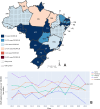

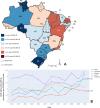
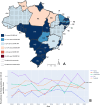
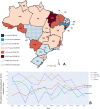
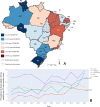
Similar articles
-
Epidemiologic profile and prevalence of live births with orofacial cleft in Brazil: a descriptive study.Rev Paul Pediatr. 2023 Sep 15;42:e2022234. doi: 10.1590/1984-0462/2024/42/2022234. eCollection 2023. Rev Paul Pediatr. 2023. PMID: 37729242 Free PMC article.
-
Orofacial clefts in Brazil and surgical rehabilitation under the Brazilian National Health System.Braz Oral Res. 2017 Mar 30;31:e23. doi: 10.1590/1807-3107BOR-2017.vol31.0023. Braz Oral Res. 2017. PMID: 28380087
-
Demographics of orofacial clefts in Canada from 2002 to 2008.Cleft Palate Craniofac J. 2013 Mar;50(2):224-30. doi: 10.1597/10-223. Epub 2011 Sep 9. Cleft Palate Craniofac J. 2013. PMID: 21905911
-
Prevalence of orofacial clefts and risks for nonsyndromic cleft lip with or without cleft palate in newborns at a university hospital from West Mexico.Congenit Anom (Kyoto). 2018 Jul;58(4):117-123. doi: 10.1111/cga.12276. Epub 2018 Mar 4. Congenit Anom (Kyoto). 2018. PMID: 29457660
-
Epidemiology of orofacial clefts in the East of ireland in the 25-year period 1984-2008.Cleft Palate Craniofac J. 2014 Jul;51(4):e63-9. doi: 10.1597/11-299. Epub 2013 Oct 17. Cleft Palate Craniofac J. 2014. PMID: 24134478
Cited by
-
Nationwide Spatial Patterns and Maternal and Birth-Related Factors Associated with Orofacial Clefts in Brazil.Int J Environ Res Public Health. 2025 Jun 24;22(7):995. doi: 10.3390/ijerph22070995. Int J Environ Res Public Health. 2025. PMID: 40724062 Free PMC article.
References
-
- Mossey PA, Little J, Munger RG, Dixon MJ, Shaw WC. Cleft lip and palate. The Lancet. 2009;374(9703) - PubMed
-
- Brasil . Saúde Brasil 2020/2021 – Anomalias congênitas prioritárias para a vigilância ao nascimento. Ministério da Saúde; Brasília: 2021.
-
- Pawluk MS, Campaña H, Gili JA, Comas B, Guiménez LG, Villalba MI. Adverse social determinants and risk for congenital anomalies. Arch Argent Pedriatr. 2014;112(3) - PubMed
MeSH terms
LinkOut - more resources
Full Text Sources
Medical

